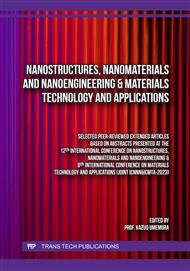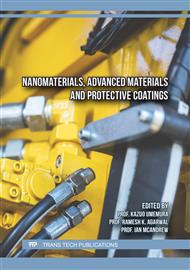[1]
Diyana, Z. N., Jumaidin, R., Selamat, M. Z., Ghazali, I., Julmohammad, N., Huda, N., & Ilyas, R. A. (2021). Physical properties of thermoplastic starch derived from natural resources and its blends: A review. In Polymers (Vol. 13, Issue 9, p.5–20). MDPI AG.
DOI: 10.3390/polym13091396
Google Scholar
[2]
Ilyas, R. A., Sapuan, S. M., Harussani, M. M., Hakimi, M. Y. A. Y., Haziq, M. Z. M., Atikah, M. S. N., Asyraf, M. R. M., Ishak, M. R., Razman, M. R., Nurazzi, N. M., Norrrahim, M. N. F., Abral, H., & Asrofi, M. (2021). Polylactic acid (Pla) biocomposite: Processing, additive manufacturing and advanced applications. In Polymers (Vol. 13, Issue 8). MDPI AG.
DOI: 10.3390/polym13081326
Google Scholar
[3]
Kamarudin, S. H., Jusoh, E. R., Abdullah, L. C., Ismail, M. H. S., Aung, M. M., & Ratnam, C. T. (2019). Thermal and Dynamics Mechanical Analysis of Polypropylene Blown Films with Crude Palm Oil as Plasticizer. Indonesian Journal of Chemistry, 19(3), 545.
DOI: 10.22146/ijc.30460
Google Scholar
[4]
Laftah, W. A., Rohah, ·, & Majid, A. (2019). Development of bio-composite film based on high density polyethylene and oil palm mesocarp fibre.
DOI: 10.1007/s42452-019-1402-7
Google Scholar
[5]
Ratnam, C. T., Min, A. M., Chuah, T. G., Suraya, A. R., Choong, T. S. Y., & Hasamuddin, W. H. W. (2006). Physical Properties of Polyethylene Modified with Crude Palm Oil. Polymer-Plastics Technology and Engineering, 45(8), 917–922.
DOI: 10.1080/03602550600723563
Google Scholar
[6]
Kassim Shaari, N. Z., Bairik, M., & Jai, J. (2020). Effect of different loading low density polyethylene (LDPE) on the thermal and mechanical properties of Tapioca starch-based plastic composite. Malaysian Journal of Chemical Engineering and Technology (MJCET), 3(1), 25.
DOI: 10.24191/mjcet.v3i1.10928
Google Scholar
[7]
Ang, D. T.-C., Khong, Y. K., & Gan, S. N. (2016). Palm oil-based compound as environmentally friendly plasticizer for poly(vinyl chloride). Journal of Vinyl and Additive Technology, 22(1), 80–87.
DOI: 10.1002/vnl.21434
Google Scholar
[8]
Wu, X. S. (2011). Effect of Glycerin and Starch Crosslinking on Molecular Compatibility of Biodegradable Poly(lactic acid)-Starch Composites. Journal of Polymers and the Environment, 19(4), 912–917.
DOI: 10.1007/s10924-011-0298-0
Google Scholar
[9]
Wang, S. H., & Yang, S. M. (2011). Preparation and Characterization of PP-g -GMS -St For PP/O-MMT Composite Materials. Advanced Materials Research, 239–242, 1143–1148.
DOI: 10.4028/www.scientific.net/amr.239-242.1143
Google Scholar
[10]
Adriana, Jalal, R., & Yuniati. (2018). Antistatic effect of glycerol monostearate on volume resistivity and mechanical properties of nanocomposite polystyrene-nanocrystal cellulose.
DOI: 10.1063/1.5042967
Google Scholar
[11]
Kaur, L., Singh, J., & Singh, N. (2005). Effect of glycerol monostearate on the physico-chemical, thermal, rheological and noodle making properties of corn and potato starches. Food Hydrocolloids, 19(5), 839–849.
DOI: 10.1016/j.foodhyd.2004.10.036
Google Scholar
[12]
Liu, L., Li, L., Wan, L., Mao, L., Li, B., & Zhang, X. (2021). Addition of glyceryl monostearate affects the crystallization behavior and polymorphism of palm stearin. Bioprocess and Biosystems Engineering, 44(5), 941–949.
DOI: 10.1007/s00449-019-02251-1
Google Scholar
[13]
Nazri Ahmad, M., Ridzwan Ishak, M., Mohammad Taha, M., Mustapha, F., Leman, Z., Bhudolia, K., & Chandrakant Joshi, S. (2021). Rheological and Morphological Properties of Oil Palm Fiber-Reinforced Thermoplastic Composites for Fused Deposition Modeling (FDM).
DOI: 10.3390/polym13213739
Google Scholar
[14]
Sudari, A., Shamsuri, A., Zainudin, E., & Tahir, P. (2017). Exploration on compatibilizing effect of nonionic, anionic, and cationic surfactants on mechanical, morphological, and chemical properties of high-density polyethylene/low-density polyethylene/cellulose biocomposites. Journal of Thermoplastic Composite Materials, 30(6), 855–884.
DOI: 10.1177/0892705715614064
Google Scholar
[15]
Liu, Z. Q., Yi, X. S., & Feng, Y. (2001). Effects of glycerin and glycerol monostearate on performance of thermoplastic starch. Journal of Materials Science, 36(7), 1809–1815.
Google Scholar
[16]
Alamri, H. R., El-Hadi, A. M., Al-Qahtani, S. M., Assaedi, H. S., & Alotaibi, A. S. (2020). Role of lubricant with a plasticizer to change the glass transition temperature as a result improving the mechanical properties of poly(lactic acid) PLLA. Materials Research Express, 7(2).
DOI: 10.1088/2053-1591/ab715a
Google Scholar
[17]
Ferro, A. C., Okuro, P. K., Badan, A. P., & Cunha, R. L. (2019). Role of the oil on glyceryl monostearate based oleogels. Food Research International, 120, 610–619
DOI: 10.1016/j.foodres.2018.11.013
Google Scholar



